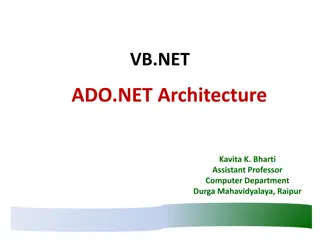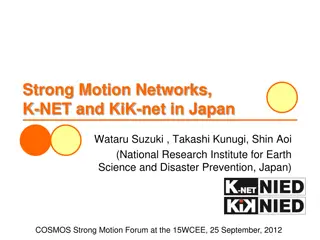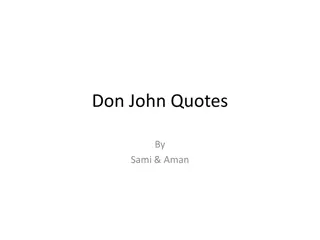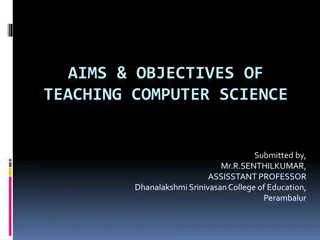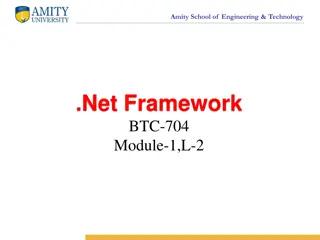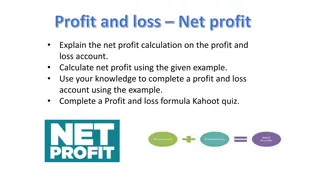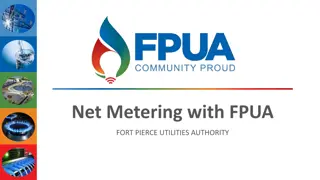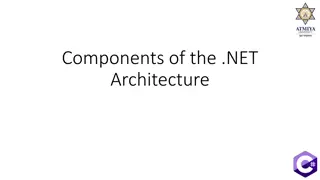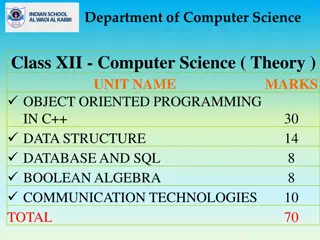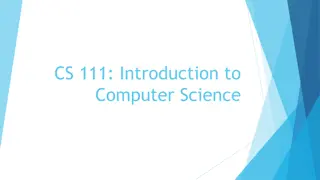A Comprehensive Guide to ADO.Net in Computer Science
Explore the world of ADO.Net with V.S. Abbiramy, Assistant Professor in the Department of Computer Science. Learn about ADO.Net's object structure, functionalities, comparisons with ADO, and its position in the .Net framework. Dive into data access classes, XML support, data access efficiency, and more.
Download Presentation

Please find below an Image/Link to download the presentation.
The content on the website is provided AS IS for your information and personal use only. It may not be sold, licensed, or shared on other websites without obtaining consent from the author. Download presentation by click this link. If you encounter any issues during the download, it is possible that the publisher has removed the file from their server.
E N D
Presentation Transcript
An Introduction to ADO.Net V S ABBIRAMY Asst. Professor Department of Computer Science
Contents What is ADO.Net? What happened to ADO? The ADO.Net object structure Connecting Commanding Readers and DataSets
What is ADO.Net? The data access classes for the .Net framework Designed for highly efficient data access Support for XML and disconnected record sets
And the .Net framework? A standard cross language interface Encapsulation of services, classes and data types Uses XML for data representation
Where does ADO sit? VB C# C++ Jscript Common Language Specification Visual Studio .NET ASP.Net Windows Forms ADO.Net XML.Net Base Class Library Common Language Runtime (CLR) Windows COM+ Services
What happened to ADO? ADO still exists. ADO is tightly coupled to client server architectures Needs COM marshalling to pass data between tiers Connections and locks are typically persisted
ADO / ADO.Net Comparisons Feature In memory data storage ADO Recordset object Mimics single table ADO.Net Dataset object Contains DataTables Data Reads Sequential Sequential or non- sequential Data Sources OLE/DB via the Connection object Managed provider calls the SQL APIs
ADO / ADO.Net Comparisons Feature Disconnected data ADO Limited support, suitable for R/O ADO.Net Strong support, with updating Passing datasets COM marshalling DataSet support for XML passing Scalability Limited Disconnected access provides scalability
.NET Data Providers SQL .NET Data Provider SQL SERVER OLE DB .NET Data Provider Client OLE DB Provider Other DB ODBC .NET Data Provider ODBC Driver Other DB
Data Provider Functionality Client .Net Data Provider Connection Command Rows DataReader DataSet DataAdapter database
ADO.Net object model Fill DataAdapter UpdateCommand DataSet Update DeleteCommand SelectCommand InsertCommand Errors Collection Command Connection Parameters Data Source
Namespaces System.Data & System.Data.Common System.Data.SqlClient & System.Data.OleDB System.Data.SqlTypes System.XML & System.XML.Schema
Using Namespaces VB.Net Imports System.Data Imports System.Data.SqlClient Dim sqlAdp as SqlDataAdapter C# using System.Data; using System.Data.SqlClient; SqlDataAdapter sqlAdp= new SqlDataAdapter();
SQL Namespace Objects using System.Data.SqlClient; using System.Data.SqlClient; SqlConnection SqlCommand SqlDataReader SqlDataAdapter SqlParameter SqlParameterCollection SqlError SqlErrorCollection SqlException SqlTransaction SqlDbType
Connecting to SQL using System.Data.SqlClient; string sConnectionString = "Initial Catalog=Northwind; Data Source=localhost; Integrated Security=SSPI;"; SqlDataAdapter sqlAdp= new SqlDataAdapter(sConnectionString); sqlAdp.Close(); sqlAdp.Dispose();
Connection Pooling ADO.Net pools connections. When you close a connection it is released back into a pool. SqlConnection conn = new SqlConnection(); conn.ConnectionString = "Integrated Security=SSPI;Initial Catalog=northwind"; conn.Open(); // Pool A is created. SqlConnection conn = new SqlConnection(); conn.ConnectionString = "Integrated Security=SSPI;Initial Catalog=pubs"; conn.Open(); // Pool B is created because the connection strings differ. SqlConnection conn = new SqlConnection(); conn.ConnectionString = "Integrated Security=SSPI;Initial Catalog=northwind"; conn.Open(); // The connection string matches pool A.
Getting data SqlCommand ExecuteReader ExecuteNonQuery ExecuteScalar ExecuteXMLReader SqlDataAdapter DataSet
Using the command object SqlCommand Multiple constructors New() New(cmdText) New(cmdText, connection) New(cmdText, connection, transaction)
Using the command object string sSelectQuery = "SELECT * FROM Categories ORDER BY CategoryID"; string sConnectionString = "Initial Catalog=Northwind; Data Source=localhost; Integrated Security=SSPI;"; SqlConnection objConnect = new SqlConnection(sConnectString); SqlCommand objCommand = new objConnect); /* objCommand.CommandTimeout = 15; objCommand.CommandType = CommandType.Text; */ SqlCommand(sSelectQuery, objConnect.Open(); SqlDataReader drResults; SqlDataReader drResults; drResults = objCommand.ExecuteReader() drResults = objCommand.ExecuteReader() drResults.Close(); objConnect.Dispose();
Command Methods .ExecuteReader() - Returns DataReader .ExecuteNonQuery() - Returns # of Rows Affected .ExecuteXMLReader() - Returns XMLReader Object to Read XML documentation .ExecuteScaler() - Returns a Single Value e.g. SQL SUM function.
The DataReader object DataReader objects are highly optimised for fast, forward only enumeration of data from a data command A DataReader is not disconnected
The DataReader object Access to data is on a per record basis. Forward only Read only Does support multiple recordsets
Creating a data reader SqlDataReader sqlReader; sqlReader = sqlCommand.ExecuteReader(); while (sqlReader.Read()) { // process, sqlReader("field") } sqlReader.Dispose();
Other Methods GetString(), GetInt() etc. GetSqlString(), GetSqlInt32() etc. GetValues() IsDBNull() GetSchemaTable()
DataSets In-memory representation of data contained in a database/XML Operations are performed on the DataSet, not the data source Can be created programmatically, using a DataAdapter or XML schema and document (or any mixture)
Creating DataSets Setup SqlConnection Setup a SqlDataAdapter Create a DataSet Call the .Fill() method on the DA
DataAdapters Pipeline between DataSets and data sources Geared towards functionality rather than speed Disconnected by design Supports select, insert, delete, update commands and methods
DataAdapters Must always specify a select command All other commands can be generated or specified
Using the DataAdapter SQLDataAdapter sqlDA = new SqlDataAdapter(); sqlDA.SelectCommand = new SqlCommand ("select * from authors , sqlConnection); DataSet sqlDS = new DataSet("authorsTable"); sqlDA.Fill(sqlDS, "authorsTable");
DataAdapters For speed and efficiency you should set your own InsertCommand, UpdateCommand and DeleteCommand Call GetChanges to seperates the updates, adds and deletes since the last sync. Then sync each type.
DataTables A DataSet contains one or more DataTables. Fields are held within the DataTable. And in DataRows, DataColumns.
Sets, Tables and Rows DataSet DataTable DataTable DataRow DataRow
Using DataTables With a DataTable we can Insert, modify and update Search Apply views Compare Clear Clone and Copy
DataRelations New to ADO.Net Tables within a DataSet can now have relationships, with integrity. Supports cascading updates and deletes.
DataViews Like a SQL view Single, or multiple tables Normally used with GUI applications via Data Binding.
References ADO.Net Programmer s Reference Bilbija, Dickenson et al. Wrox Press http://oberon.idunno.org/sql/ My email : desai8@uwindsor.ca
Thank You!! -Marmagna Desai


